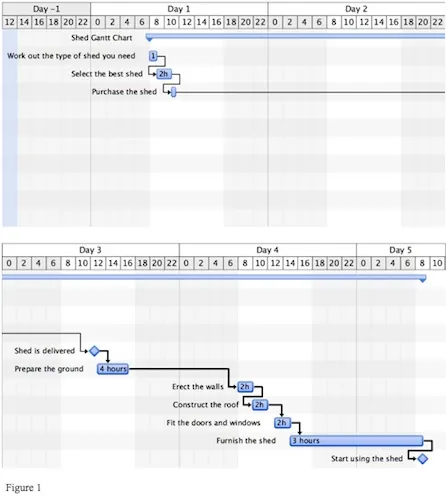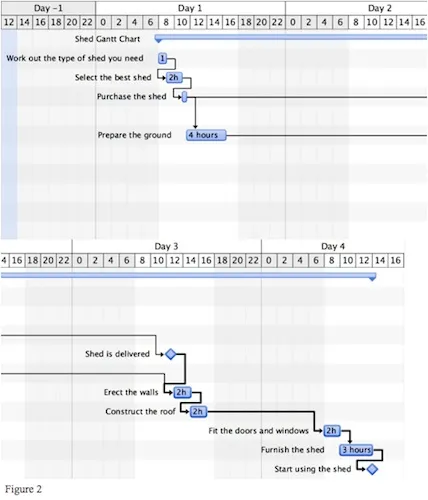Project planning is all out working out your plan in time and space. In The Right Questions Framework, the ‘When’ question relates to the ‘How’ of tasks and resources. As well as mapping these against time the ‘when’ also revisits the concept of priorities, first looked at under ‘why’. Putting this all together brings us to the concept of programming. There are various ways to graphically show a time-based plan but the Gantt Chart is probably the best known and most frequently used.
Programming
I was part of the initial project management team working on the construction of ‘The Shard’, the new tower above London Bridge station, which is the tallest building in Western Europe. It goes without saying that it is massive and complex; too big to contemplate in all its detail. What’s more, it is unique, there is not another building quite like it anywhere in the world. Considering this, how could someone possibly decide how long it was going to take to build? The key, as we looked at it under the ‘How’ question, was to break the whole plan down into manageable pieces. It is hard to estimate how long it will take to build a 330m tower, but you can start by working out how long it will take to construct one pillar or fit one window.
We can do the same for our goals. We are already mostly there as under ‘How’ we broke down our dreams into goals and our goals into tasks. It should be easier to assess the time for one task and if we need even greater accuracy we can break the task down into steps and work out the duration for those.
By doing this we are building up a programme (a plan with timings) to achieve our vision. We have identified goals, worked out the necessary tasks and resources and now given time to each step. Through this process, the dream starts to become more tangible. Once again, don’t worry if you can’t work out everything – the important thing is to know the next few steps in enough detail to start to act.
Free Personal Leadership Action Plan
Just sign up here to receive your free copy
Critical path analysis and keeping things simple
If you work out all of the activities that you need to achieve and the duration of each task then you will have a fully functioning programme; the sort of thing a project manager will create. When you put all your activities into sequence the quickest route through the plan becomes the ‘critical path’ and gives you the shortest duration to achieve your aim.
Remember: a programme can include as little or as much detail as you need. The important thing is that the programme helps you to plan and helps you track your progress towards a goal. My advice is to start simple and if you can’t fit it legibly on one A4 page, or it starts being hard to understand, simplify it.
Gantt Chart Example
Earlier when we looked at tasks and milestones we looked at the example of building a shed. Let’s use the same example to make a simple programme. We can start by estimating the duration for each activity:
- Work out what type and size of shed you need and where it will go. We will need to go out and do some measuring so let’s assume 1 hour.
- Select the best shed to suit your purpose. This might require some time researching on the internet so let’s give ourselves 2 hours.
- Purchase the shed. I am planning to do this online, so once I have decided on the right shed, it should only take me only a few minutes. It is a good idea to always give ourselves 30 minutes, even for a simple task, so I am going to assign a half-hour here.
- The shed is delivered. This is a milestone so I will not give it a duration. But, there is likely to be a time lag between purchasing and delivery and I will assume it will be 48 hours between payment and receiving the goods.
- Prepare the ground. I will need to level the ground and my garden is on a slope so this is likely to take some time. I will initially give myself 4 hours. This could take longer, especially if foundations are required. So I might have to re-calculate this after inspecting the ground and the shed I have chosen.
- Erect the walls. I am going to allow myself 2 hours for this task. This job will probably require the help of another person. I will have to ask someone to help soon to prevent my project from being delayed.
- Construct the roof and make it waterproof. Again I will estimate around 2 hours for this.
- Fit the door and windows. This could be a fiddly job so once again I am going to give myself 2 hours here
- Furnish the shed ready for use. This will likely require popping to the shops again so I am going to give myself 3 hours for this.
- Start using the shed. This is a milestone so I won’t give it a duration.
Now we can create a pictorial representation of the programme. This is known as a Gantt Chart (named after Henry Gantt, the man who developed the idea). Putting all the activities into the correct order, I have created a Gantt Chart. You can see the first version in Figure 1:
You will notice that as I start to fit the tasks into normal working hours, some activities roll forward. Now they take place over several days. I can now see that I won’t be able to start using the shed until the 5th day.
Leadership Development: Master the Top Leadership and Life Skills
Better lead in life and work to maximise your success. Sign up and access materials for free!
Prioritising
“Time is free, but it’s priceless. You can’t own it, but you can use it. You can’t keep it, but you can spend it. Once you’ve lost it you can never get it back.” Harvey MacKay
Time is limited so therefore within the plan we need to prioritise. There is never enough time to do everything. Therefore, we need to be able to decide which things to forgo. Our values point us towards our priorities and that helps us make the right decisions, especially when under pressure.
We have to know the tasks that are vital to success but this is not always straightforward to ascertain. Therefore, we may need to go through a process of elimination until we can perceive the essential elements.
Which things can be done concurrently? Which tasks could you delay or rearrange? What could you delegate or even dispense with altogether? By asking these sorts of questions you get down to the bare bones of what are the vital actions. You may well find that you can refine your programme after asking these questions.
For example, looking at our shed project again I can see that I don’t need to wait for the shed to arrive in order to prepare the ground. I can save myself some time by starting this task while I am waiting for the shed to be delivered as you can see in Figure 2:
You can see that by getting on with the groundwork concurrently I have reduced the total duration of the project by a day. Therefore, I will now be able to start using the shed on day 4.
Cash Flow and Budgeting
After adding the duration to the tasks the next thing to do is to add the resources needed for each activity. This is the next layer of the programme and can be added to your table or spreadsheet.
In this way, we can establish not just the cost of any task but also the yearly, monthly, weekly or daily cost of a goal or activity. In other words, we create a cash flow forecast or budget.
After doing all this you should be able to link the dream you have right through to the very next step you need to take. Hopefully, you will also know exactly how long it will take and how much it will cost. You can now put that step in your diary and you are on your way!
Project Management Programming Software
The Gantt Charts for this post was created using Merlin Project Management Software. Merlin 2 is the best project management programming software that I have used for the Mac and if you want to find out more or try a demo then click here.
Merlin is very similar to Microsoft Project, the main software I have used on PC. This is something of the industry standard for project management software, although perhaps not the best.






